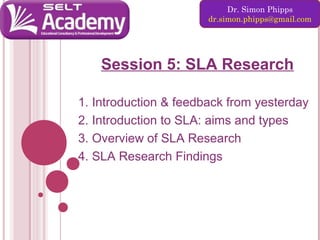
CTS-Academic: Module 2 session 5 sla research
- 1. Dr. Simon Phipps dr.simon.phipps@gmail.com Session 5: SLA Research 1. Introduction & feedback from yesterday 2. Introduction to SLA: aims and types 3. Overview of SLA Research 4. SLA Research Findings
- 2. WHAT IS SLA? SLA is; an attempt to understand how people of different L1s ages attitudes succeed or fail in linguists psycholinguists sociologists neurologists anthropologists AND teachers social backgrounds natural or formal settings Who does it interest? intellects
- 3. SLA RESEARCH – AN OVERVIEW L2 L1 Classroom Individual differences Role of instruction Types of interaction Age Aptitude Motivation Personality Strategies Natural environment Error correction Q types Negotiation Developmental sequences Types of input Form/meaning CI Error analysis Morpheme studies L1 influence
- 4. SLA Research: some background 1 Why SLA? migration English as a world language mixed communities - USA, AUS, NZ BRITAIN CANADA A History of SLA 1960s - early 1970s (very little) descriptive (error analysis, morpheme studies, learning strategies) late 1970s - 1980s (explosion) explanatory (immersion studies, development sequence) 1990s – today (huge area) explanatory (classroom-based, more pedagogical focus)
- 5. How useful is SLA research? What can it tell us as teachers? What would you like to find out more about?
- 6. CONTEXTS FOR LANGUAGE TEACHING (ADAPTED FROM LIGHTBOWN & SPADA 2006:111) Characteristics Natural environment Grammarbased teaching Communicative teaching x √ √ √ x √ ? ? Learning one thing at a time Frequent feedback on errors T-st st-st Ample time for learning √ x x x Exposure to proficient users √ x? ? x √ x Variety of language types Pressure to speak Access to modified input ? ? √ √ ? ? x √ √ ?
- 7. CLASSROOMS Error correction corrective feedback sts notice more if they are in a form-focused activity recasts hard for sts to notice more likely to be noticed if directed at other students Questioning techniques open vs closed Qs genuine vs display Qs genuine Q = more processing, more complex responses scaffolding and display Qs open = more complex responses use of display Qs to check understanding = useful wait time more wait = better responses
- 8. SLA RESEARCH FINDINGS 1 Order of Acquisition (for children in L1) present continuous (-ing) plural (-s) irregular past forms (went, had) possessive (‘s) copula (‘be’ as main verb) articles (the/a) regular past (-ed) 3rd person (-s) auxiliary (‘be’) (from Lightbown, P. & Spada, N. (1993). How Languages are Learned. Oxford: OUP. p58)
- 9. SLA RESEARCH FINDINGS 2 (Ellis 1994, 1997, Lightbown & Spada 1993, 2006, Larsen-Freeman & Long 1991) 1. Order of Acquisition Similar stages of learning learners learn when they are ready despite L1, teaching order similar for L1 and L2 in natural settings Frequency is not the crucial factor Psycholinguistic processing difficulty some items are inherently easier to learn ‘Teachability/Learnability Hypothesis’ (Pienemann 1989) similar sequence, varied order U shaped learning language learning is not a linear process
- 10. SLA RESEARCH FINDINGS 3 2. Formal instruction 2.1 Instruction vs. Natural Environment • teaching = learning? • little effect on order of learning • instruction is helpful for • rate of attainment, if the learner is ready level of attainment CI alone = not enough good for confidence, fluency; not accuracy CI alone = some fossilisation FI speeds up slow process of natural discovery Learners can learn AND acquire 2.2 Error Correction • can interfere, can help • useful to point out persistent errors which learners don’t notice L2 learners need negative evidence (L1 positive evidence is enough)
- 11. SLA RESEARCH FINDINGS 4 2. Formal instruction (continued) 2.3 Form vs Meaning Course which focuses mainly on form interferes with IL development learners are unable to communicate effectively Course which focuses mainly on meaning inaccurate language language (ab)use conscious learning of rules seems to help automisation need for CI + CO ‘.. form focused instruction and corrective feedback provided within the context of a communicative programme are more effective in promoting second language learning…’ (Lightbown, P. & Spada, N. 1993 How Languages are Learned Oxford:OUP p 105)
- 12. SLA RESEARCH FINDINGS 5 3. Individual differences (Social factors can affect success of individual learners) Cognitive and affective dimensions; Age no sudden cut-off (gradual curve) crucial for pronunciation there are exceptions, but L2 learners are generally less successful than in L1 Intelligence / Aptitude seems to be important, but what is it? affects knowledge not use multiple intelligences different effects for different aspects memory / phonemic coding ability / inductive ability Personality (and learning styles) need to match teaching and learning styles memory-oriented vs analytic learners importance of self-esteem
- 13. SLA RESEARCH FINDINGS 6 3. Individual differences (continued) Motivation motivation is important, but less clear what it is instrumental, integral, intrinsic, resultative motivation is dynamic (varies during a lesson/task) learners evaluate benefits /threats when deciding whether to invest effort Strategies (and the Good Language Learner) affected by motivation and aptitude success = more use of strategies hard to identify links between strategy use and learning need to know more about strategy use and language processing
